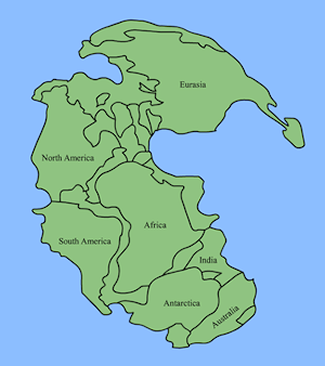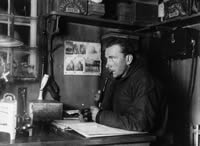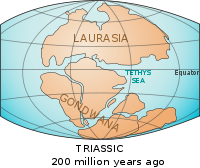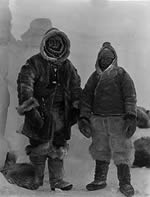
Pangaea and Continental Drift
Travel Back in Time to Pangaea
Imagine that you are traveling through time and your time machine malfunctions, sending you to a time in the distance past. When you arrive, you open the door and find yourself in a tropical world filled with large reptile like creatures, giant tropical ferns, and a warm muggy climate. You remember this from your Earth science class —giant reptiles, warm, wet...it must be during the time of the dinosaurs.

Map of Pangaea, Kieff: Creative Commons 3.0
It seems that the time machine has placed you somewhere in the late Paleozoic Era or early Mesozoic Era. You remember that during this time all land is connected in a super continent named Pangaea, which means "All Land". Also during this time there was only one ocean, named the Panthalassa Sea, meaning "World Ocean".
But if all land was connected how did it break apart and separate? Before you spend too much time here, you get back into the time machine as it would not be safe to even try and witness a dinosaur up-close!
After making a few adjustments you enter the new date you want to travel to: 200 million years ago. You set your coordinates to place you on the most eastern tip of what would be present-day South America, but in Pangaea it's where South America meets Africa. This location should help you answer the question.
You hear your time machine making contact with the ground. Again you open the door to find a completely different landscape than before. The land is rugged and broken with magma pouring out of the ground in some places.
You look to the east and west and see a mountain ranges, so you must be in a place where the ground is pulling apart. Suddenly you hear a sound! It is loud, so you turn to see a large dinosaur quickly running your way. Time to get out of here!
![]() Learn how the continents separated in this video about Pangaea (02:21) from Discovery Education™ streaming.
Learn how the continents separated in this video about Pangaea (02:21) from Discovery Education™ streaming.
Meet Alfred Wegener

Alfred Wegener
Archive of Alfred Wegener Institute:
Public Domain
Without having a chance to truly get your answer, you remember two more things from your Earth science class: a name of Alfred Wegener, and a date of 1911.
You enter '1911' into the time machine computer right before the dinosaur makes contact with you, and off you go. When you land this time you are in Germany in 1911. A man is working at his desk. He has many maps of the world. It must be the famous Alfred Wegener himself.
You walk up and look at Wegener's maps, which have all of the land connected and are labeled Pangaea. The ocean is labeled Panthalassa Sea. There's one more sea named the Tethys Sea. It is a large sea enclosed by land on three sides on the eastern portion of Pangaea.
![]() Learn more by viewing this video about Alfred Wegener (02:21) from Discovery Education™ streaming about what led Wegener to propose his theory of continental drift.
Learn more by viewing this video about Alfred Wegener (02:21) from Discovery Education™ streaming about what led Wegener to propose his theory of continental drift.

Tethys Sea just after break-up of Pangaea
Lenny222: Creative Commons 3.0
Wegener spots you from his desk on the opposite side of the room. He is not happy with your sudden appearance in your weird time machine. You race back to the machine one more time, but on your way you spot two novels bound together. You grab them, get into the time machine, and punch 2011.
You arrive at home and start reading Wegener's two novels. In Continental Drift, written in 1912, you learn about Wegener's ideas about seafloor spreading, continents breaking apart, and the Earth's rotation causing the plate motion.
Then you skim through his second book, The Origin of Continents and Oceans, from 1915 (revised in 1922). Here you learn more about Wegener's proposal that the land was all connected in one super continent. What makes this second book so great is the amount of evidence from several fields of science that Wegener describes.

Wegener's Proposed Fossil Patterns across Continents
USGS: Public Domain
Here is a summary:
- Africa and South America look like puzzle pieces that have been connected and separated.
- In 1855, German Scientist Edward Suess found fossils of the Glossopteris fern in South America, Africa, Australia, India, and even the Antarctic. The seeds of the fern were much to heavy to travel by wind and too fragile for water travel. This means the landmasses had to have been close together.
- Other fossil evidence includes Cynognathus, Mesosaurus, and Lystrosaurus. All of these dinosaurs were reptiles that were not believed to migrate far. So the land had to have been together for them to be found on every continent.
- Glacial evidence was found in now tropical areas of South America, Africa, Madagascar, Arabia and India. This evidence is in the form of similar age sediment.
- Mountain ranges line up in North America and Europe and the same rock structure are found in each range.
- Coal distribution was found in matching areas of North American and Europe suggesting those to continents were together.

Alfred Wegener on Expedition
Archive of Alfred Wegener Institute:
Public Domain
Wegener had one crucial flaw in his theory. He did not properly explain how the continents broke apart. Wegener believed that that the continents broke apart around 175-150 million years ago, because of the force associated with a rotating Earth. This is not correct.
However, the land did break apart and the northern half stayed together in a landmass called Laurasia (now North America, Europe, and Asia). The southern portion also stayed together in a landmass called Gondwanaland (now South America, India, Australia, and Antarctica).
Unfortunately, Wegener never lived to see his theory come to life. He disappeared during an expedition in 1930. Maybe he too had a time machine?
But why did the continents move?
To find that answer to this question you must first learn about seafloor spreading.
Pangaea and Continental Drift Review
![]() Now that you have investigated Pangaea and Continental Drift, test your knowledge. Take a moment to try and list all of the pieces of evidence that supported Alfred Wegener's Theory of Plate Tectonics. How many can you list? Did you list them all? Check your list by reviewing the content presented in this topic.
Now that you have investigated Pangaea and Continental Drift, test your knowledge. Take a moment to try and list all of the pieces of evidence that supported Alfred Wegener's Theory of Plate Tectonics. How many can you list? Did you list them all? Check your list by reviewing the content presented in this topic.


